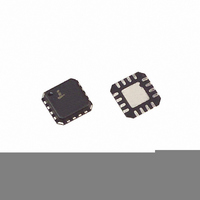ISL6297CRZ-T Intersil, ISL6297CRZ-T Datasheet - Page 8

ISL6297CRZ-T
Manufacturer Part Number
ISL6297CRZ-T
Description
IC CHARGER LI-ION POLYMER 16-QFN
Manufacturer
Intersil
Datasheet
1.ISL6297CRZ-T.pdf
(16 pages)
Specifications of ISL6297CRZ-T
Function
Charge Management
Battery Type
Lithium-Ion (Li-Ion), Lithium-Polymer (Li-Pol)
Voltage - Supply
4.3 V ~ 6.5 V
Operating Temperature
-20°C ~ 70°C
Mounting Type
Surface Mount
Package / Case
16-VQFN Exposed Pad, 16-HVQFN, 16-SQFN, 16-DHVQFN
Lead Free Status / RoHS Status
Lead free / RoHS Compliant
Other names
ISL6297CRZ-TTR
As shown in Figure 3, the charge current is I
.
than I
level, the charge current starts to decrease. The AC/DC
supply moves out of the current-limit region and becomes a
voltage source again. When the charge current reaches a
programmable end-of-charge (EOC) level set by the I
pin, the charger sends out an EOC indication.
When using a current-limited adapter, the thermal situation
in the ISL6297 is totally different from the voltage limited
case. Figure 3 shows the typical charge curves when a
current-limited adapter is employed. The operation requires
that the I
current I
operation under such conditions occurs during the CC mode.
The power dissipation in the CC mode becomes:
where r
fully turned on. This power is typically much less than the
peak power in the traditional linear mode.
When using a current-limited adapter, the worst power
dissipation typically occurs at the beginning of the CV mode,
as shown in Figure 3. Equation 1 also applies to the dual
mode operation during the CV mode. When using a very
small PCB whose thermal impedance is relatively large, it is
possible that the internal temperature can still reach the
thermal foldback threshold. In that case, the IC is thermally
protected by lowering the charge current, as shown with the
dotted lines in the charge current and power curves.
Appropriate design of the adapter can further reduce the
peak power dissipation of the ISL6297. One simple
approach is to design the AC/DC converter output voltage
just high enough (normally lower than 5V) to fully charge the
P
CH
FIGURE 3. TYPICAL CHARGE CURVES USING A CURRENT-
I
REF
REF
=
V
V
I
I
V
REF
/10
MIN
LIM
DS(ON)
CH
P
P
r
IN
LIM
DS ON
1
2
REF
. As the battery voltage reaches the 4.2V V
TRICKLE
(
Trickle
MODE
Mode
of the adapter. The key difference in the charger
level be programmed higher than the limited
LIMITED ADAPTER
)
is the resistance when the main MOSFET is
×
I
CHARGE
CURRENT MODE
Input Voltage
Current Mode
CONSTANT
VOLTAGE
Constant
INPUT
2
8
TIMEOUT
VOLTAGE MODE INHIBIT
Voltage Mode
CONSTANT
POWER DISSIPATION
Constant
BATTERY VOLTAGE
Power Dissipation
Battery Voltage
CHARGE CURRENT
Charge Current
LIM
and is lower
Inhibit
CH
MIN
(EQ. 2)
ISL6297
battery. More information can be found in the ISL6292
datasheet available at http://www.intersil.com.
Functional Overview
After applying power to the ISL6297, but before charging
starts, the ISL6297 gives a “Plug-in indication” by
sequencially turning on a red, a green and a yellow indicator.
The indicator then turns off. This verifies that the AC/DC
adapter and the ISL6297 have properly powered up.
The ISL6297 then waits in an idle mode until the enable pin
indicates that the battery pack has been plugged in. A
500ms delay give time for the pins to be connected prior to
the start of a connection verification operation.
In the connection verification, the ISL6297 determines if the
battery positive pin is connected. If not, the charge operation
does not start and the LED remains off.
If the battery is firmly connected, the ISL6297 checks to see
if the battery is good and that the battery connection is not
short-circuited. If no faults are detected the ISL6297 starts a
trickle charge and turns on the red LED charge indicator.
Once the battery voltage reaches V
a constant current until the battery voltage reaches V
ISL6297 then holds the voltage constant. As the battery
charges, the current supplied to the battery decreases.
When the charge current drops to I
an EOC indication, which consists of the LED changing
colors from red to green. An end of charge indication will
also occur at the end of a user programmable TIMEOUT
period even if the cell is not completely charged.
If the battery voltage drops to a recharge threshold after the
end of charge, the ISL6297 recharges the battery until the
voltage again reaches 4.2V and the current drops below
I
cycle continues indefinitely until the charger is turned off by
disconnecting the battery, which sets the EN pin high.
An external NTC thermistor allows the ISL6297 to monitor
the ambient temperature. If the ambient temperature is out
range, the charger will not operate. Because the printed-
circuit board (PCB) temperature rises during charge, the
ISL6297 provides a higher temperature limit during the
charge operation.
The ISL6297 also features a thermal-foldback function that
reduces the charge current if the IC internal temperature
reaches +100°C to prevent further temperature rise.
Applications Information
Power-On Reset (POR)
The ISL6297 has a 3.4V rising POR threshold. Before the
input voltage reaches the POR threshold, the V2P9 pin
outputs 0V and the charger is disabled. Once the POR
threshold is reached, all counters are reset to zero, the
MIN
. At this point, the charger again turns off. The recharge
MIN
MIN
, the ISL6297 issues
, the charger outputs
July 30, 2007
CH
FN9215.2
. The











